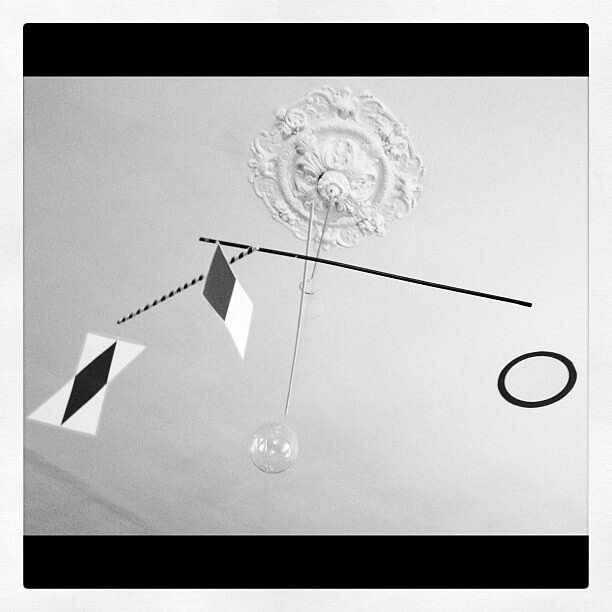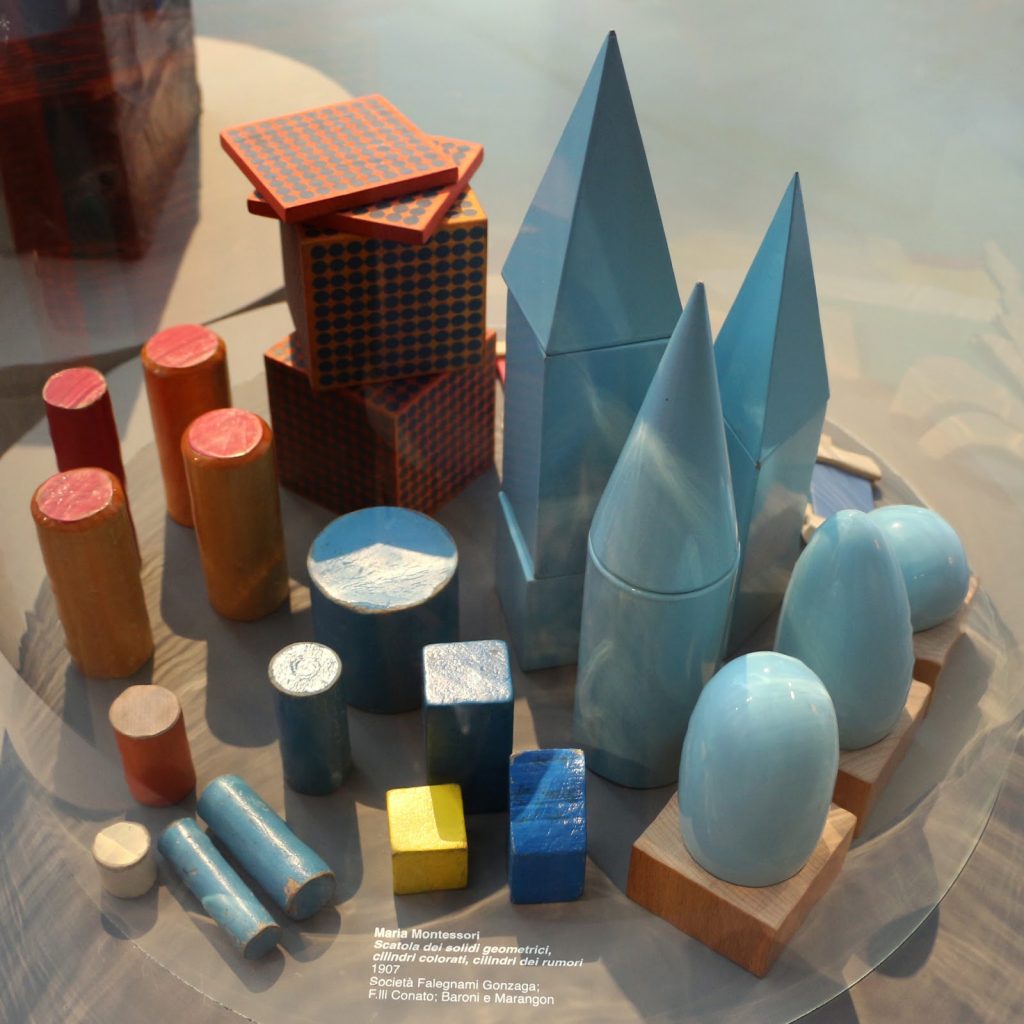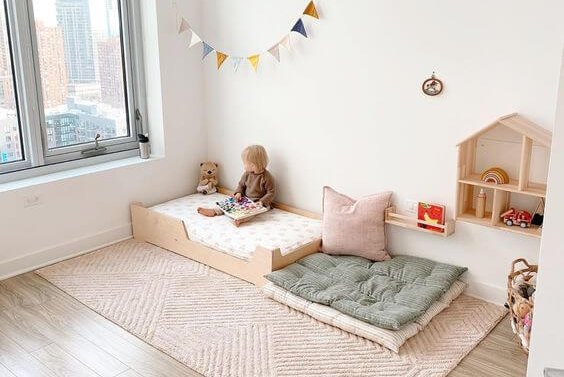New parents are often overwhelmed in setting up their baby’s room. A Montessori nursery is a simple yet practical and cozy space that is surprisingly easy to set up. The use of natural materials, muted colors, and safe furniture, with all materials accessible by your little one, is what Montessori nurseries are about.
Here are some simple things to remember while setting up a Montessori baby room.
Movement and Play Spaces
A Montessori nursery allows your child to freely and safely move around their space. If something draws their attention, they must be able to access it easily without your help. Like in a Montessori education setup, play items must be neat and organized for a clutter-free space.
Montessori Mobiles
Mobiles are essential for the first few months of your newborn to help form their vision. They assist in visual tracking, concentration, and visual discrimination, while also helping with their motor skills.

The ideal place for Montessori mobiles is in your baby’s movement area, away from their sleeping or resting space. You must start with the visual mobiles for your newborn and then move to tactile mobiles (also called a baby gym) when they’re ready for it.
Low Shelves
A Montessori nursery needs low, open shelving to hold toys, books, and other items of exploration. Such a prepared environment ensures your child can access what they want to play with on their own. Keeping these shelves clutter-free will avoid overwhelming your little one. Remember, less is more for children.
Accessible Toys
Montessori toys that promote open-ended and sensory play must be arranged in an orderly way on a low shelf for your little one to pick out and put back easily. You could rotate toys if you notice your child gets bored with the ones you’ve kept out.
Play Gyms
A play gym is a beautiful and fun addition to a Montessori-style bedroom. The ones made of natural materials are non-toxic and lack flashy toys and bright colors to avoid overwhelming your little one. It encourages floor time, and once your child has outgrown it, there are other creative uses for it.
Mirror and Barre
A mirror is a perfect centerpiece for the movement and play area of your child’s Montessori room. It encourages social, cognitive, and physical development and sparks their imagination and curiosity by seeing their reflection and the room’s reflection.
For safety, a shatter-proof acrylic mirror securely fastened to the wall in a low-hanging, horizontal position would be best. The barre can help babies pull themselves up, even before walking.
Pikler Triangle
This playscape isn’t a formal must-have for a Montessori nursery. However, this triangle does help promote practical and imaginative learning and keeps your child engaged in active play.
Functional Wooden Toys
Children love to pretend play, and functional wooden toys in a Montessori space help in open-ended pretend play. A simple wooden sink without excessive accessories, decals, or distracting clutter is a good mimic of a kitchen. Your child will enjoy playing with this once they’re able to stand.

Visual Design
A Montessori nursery is meant to be a calm, peaceful environment. Using natural materials (wood and fabric), mostly neutral color palettes, and natural light keep it visually simple.
Decorating Ideas
With a minimalist approach, Montessori rooms can have wall decor hung at your child’s level. You may use black and white images for newborns.
You could also include some plants or a small fish tank to add to your baby’s visual interest.
Neutrals
Unlike a traditional nursery that may incorporate colors, a Montessori nursery has a serene and natural theme.
The natural or neutral colors help provide a soothing effect and help concentrate and maintain focus. Do ensure there’s ample natural light in the room.
Rainbows
As much as you wouldn’t want to overwhelm your little one with too many toys or colors and stick to soft, natural palettes for the nursery, there’s no denying that babies thrive on color too.
It would be nice to add some lovely rainbow pieces to the play-items collection and incorporate wall art that encourages color exploration.
Low-Hanging Pictures
A nice touch to your little one’s nursery is to hang a few family photos or some artwork of nature or people in frames. Try keeping it simple and low for your baby to be able to see it. For safety purposes, use plexiglass instead of glass for the frames.
Practical Spaces
You need the proper Montessori bedroom setup to incorporate Montessori and teach your child practical life skills.
Open Closet/Wardrobe
An open closet/wardrobe is the perfect piece of furniture for your child to be independent and dress up as they want each day. Leaving out their entire wardrobe could overwhelm them and lead to quirky dressing styles.
Keep a limited selection of clothing items and a couple of shoes for them to pick from. You could keep most of their remaining items in a dresser or a closet.
Adult Stool
Don’t you need a place to sit when you spend quality time with your child in their room? An adult stool is an appropriate addition to a Montessori room to let you interact in your little one’s space.
Feeding Area/Chair
A feeding area with a comfortable feeding chair is essential in a Montessori nursery for a mother to bond with her baby. It makes for convenience and comfort during feeding times.
Child-Sized Furniture
A Montessori nursery is meant to provide comfort and convenience for your child. Using child-sized furniture is essential to encourage independence and ownership of their bedroom. Your little one must have easy access to what they’d like to take or do without your assistance.
Montessori Floor Bed
While it is common to see a crib in any traditional nursery, a Montessori nursery involves the use of floor beds. It could be a mattress on the floor or a bed with a very low bed frame.

Using a floor bed promotes the Montessori principles of providing your child the freedom of movement and a controlled environment. Once your baby transitions to a toddler bed sleeping arrangement, this is the ideal choice. They can independently explore their room unassisted in or out of bed.
Floor Pillows
Before your baby begins turning over and crawling, the concept of floor play can still be implemented. You could use a floor pillow or mat for tummy time while ensuring that the floor is clutter-free.
You needn’t get rid of it when your child grows up; it could be used for creative play or a dedicated space for them to think and play.
Safety
A Montessori nursery is a safe space for your child to explore; baby-proofing is integral to Montessori nurseries right from the start.
Low shelves, while providing accessibility to your child, must be anchored to the wall to avoid accidents. The use of a floor bed also makes for safe sleeping.
It’s evident that with a safe nursery, your child can explore freely and confidently without being told off constantly.
Summary
If you’ve decided to take your little one on a Montessori journey, setting up a cozy, peaceful, and safe Montessori nursery is an integral part of this journey.
It’s less likely to be overwhelming to design a Montessori nursery and toddler room for your child. All you need to do is keep the arrangements simple and minimal. Remember, the intention is to allow your little one to explore freely and safely while not overwhelming them.
Not only does it help with your baby’s development, but it also promotes independence and curiosity to explore. Don’t forget, with babies, less is always more.









